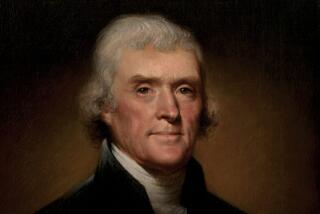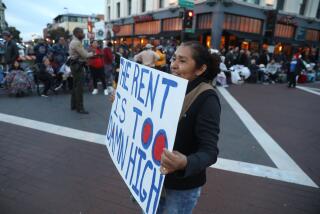The wealth divide
- Share via
We hear a great deal these days about the top 1% and the bottom 99% in the American economic pyramid. But we also need to consider the 11%.
From 1776 to the present, the bottom 60% of the American population, as USC historian Carole Shammas has documented, has never had more than 11% of the country’s wealth. We may embrace the American dream of broad prosperity and wealth equity, but we have never been close to achieving it.
There has been an explosion of studies examining inequality in the United States recently. They have been both illuminating and, at times, confusing. Sometimes people refer to the top 1% and bottom 99% using income, and at other times the studies look at wealth. Sometimes they have focused on individuals, sometimes on households, where there might by two or three earners.
Does it matter? Yes. Let’s start with the difference between income and wealth. The top 1% of today’s earners make more than $700,000 annually, and the top 1% in terms of wealth have assets of more than $9 million.
There’s a big difference between the two kinds of money. Income lasts only as long as you have the job, and it has a tendency to get spent once it’s earned. Income taxes, which are hard to evade on earnings, come out of it, as do the expenses of daily life. But wealth is forever, as long as the possessor can resist risky investments and live on the income from it rather than the principal. Many of the returns on acquired wealth come from capital gains, which are taxed at a lower rate of 15%. Other returns are sheltered from taxes in a variety of ways.
It is a lot better for the pocketbook, it turns out, to have a trust fund than to work as a stock trader, especially in a downturn like ours. Enduring wealth also translates into enduring political power in our system.
And what about wealth for the rest of us? How are we faring? Let’s consider the situation of those American households in the second quintile of wealth, those who find themselves in the 60th to 80th percentiles in comparison with other American households. This group took a serious hit in the Great Recession. For most middle-class families, the biggest items in their strongboxes are their homes and their retirement savings — 401(k)s and the like. Our persisting crisis has put 23% of mortgage-holders underwater, meaning they owe more on their houses than they are worth. Even the 77% of mortgage-holders who aren’t underwater have taken a substantial reduction in the worth of their property, as have those 30% to 40% of homeowners who have no debts or encumbrances on their houses. And retirement savings have also been battered by an unpredictable stock market and low interest rates on savings accounts.
Inequality as an issue has simmered just beneath the surface of public concern over the last quarter of a century as the median income of American households has fallen by about 4%. The wealthiest Americans have experienced a very different reality. Consider the top one-tenth of 1%. For the two decades before the recession, the American economy saw greater productivity and more wealth generation, but despite the predictions of supply-siders, little of that wealth trickled down. Instead, it redounded in a hugely disproportionate way to the benefit of the 13,000 households in the top 10th of the top 1%.
Never in the history of the United States has there been such a concentration of wealth in the hands of a small elite. We now rank 27th in the least-equal countries, falling between Portugal and Chile.
But let’s get back to the bottom 60% of American households and how they have never enjoyed more than 11% of the country’s wealth. Doesn’t that figure suggest we should review the content of the American dream and emphasize what is actual rather than illusory? We have a constitutional government, widespread enjoyment of personal freedom and government policies that protect opportunity. Perhaps the current public conversation about the 1% and 99% can focus on the fundamental question of how long political equality can survive amid such economic inequality.
Joyce Appleby is an emeritus professor of history at UCLA and the author of “The Relentless Revolution: A History of Capitalism.”
More to Read
A cure for the common opinion
Get thought-provoking perspectives with our weekly newsletter.
You may occasionally receive promotional content from the Los Angeles Times.






